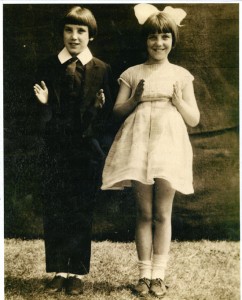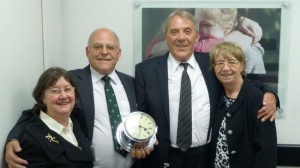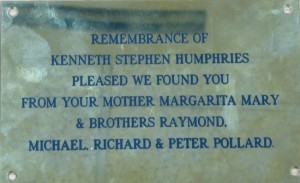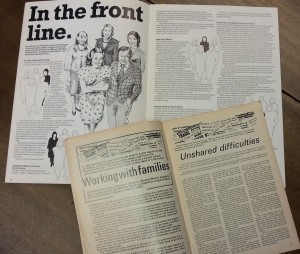Early in 2014 The Children’s Society Archive was contacted by the Legacies Team who wondered if we could shed any light on a mysterious find. One of the team had unearthed a ship’s clock from a cupboard with some information that it came from the Bede Home in Wakefield, West Yorkshire and was dedicated to the memory of Kenneth Humphries, a former resident of the Home, following his death in 1953. They hoped we could supply some further details about Kenneth. By an extraordinary co-incidence at that very time I was looking into Kenneth’s case as his half brothers had requested information on his time in the Society’s care.
Kenneth’s brothers had not known a great deal about him when they first enquired; not even his name. They were aware that he had been born to their mother, Margarita Humphries, some years before she married their father, and as she herself had been looked after by The Waifs and Strays Society for most of her childhood, it seemed likely that we would have some information on his birth. (The Children’s Society was known as The Waifs and Strays Society until 1946.) Margarita had died in 2001. From the details they supplied I was able to find substantial case files for both Margarita and her son, Kenneth. Kenneth’s brothers were delighted. They were keen to find Kenneth and incorporate him into their family.
For more historic cases, part of the service we offer to relatives of those people formerly in our care, is to provide a summary account of their family member’s time with the Society. As I started to read Margarita’s file it became evident that she and her family had a very hard time in the difficult conditions of post First World War London. Margarita was born in February 1918: her mother, Emily, was unmarried at the time and it appears that her father, who was a sailor, was drowned shortly afterwards, another casualty of the War. Emily married a labourer, Ernest Eddy, and had another daughter but the family struggled to earn enough to live on: Margarita’s stepfather was often out of work and they faced eviction from their home in Ealing because they could not pay the rent. In desperation they asked if Margarita could be taken into a Home and were helped to make an application to The Waifs and Strays Society. The little girl was accepted and was admitted to St Elizabeth’s Receiving Home, Clapham, in September 1924. Life did not improve for her parents. Emily became ill and died in hospital in November 1924 and Ernest was reduced to living in common lodging houses, taking temporary work when he could find it. Margarita’s half sister was sent to live with her grandmother. The Society agreed to continue looking after Margarita free of charge, as there was no other family to help.
After a spell in foster care Margarita was sent to St Agatha’s Home, Princes Risborough, in September 1926 and she remained there until she went out to work. She was described as “a nice little girl” and seems to have had a fairly happy time in the Home. When she was aged 17, Margarita was found a job in domestic service but this type of work did not suit her and in March 1934 the Society eventually found work for her in a small private laundry in Sussex. Margarita was popular with her employers as she had a pleasant personality; however they noted that (in common with many people) she preferred going to the pictures to working!

Margarita (on the right) and a friend performing a “doll dance” at a fete

Margarita (on the right) with her doll
It was while she was working in Sussex that Margarita became pregnant; sadly she found herself abandoned by her boyfriend who refused to admit responsibility for the pregnancy. Her employers were sympathetic but requested her removal. The Society after-care workers stepped in to help her and together with a local welfare society found her a place in a Maternity Home. It was in this Home in Eastbourne that Kenneth was born in February 1936. Margarita was a devoted mother and kept in close touch with Mrs Phillips, who worked for The Waifs and Strays Society as the Girls Welfare Secretary, and who was delighted that Margarita was so happy with Kenneth. Mrs Phillips hoped the baby would “be a real anchor” for Margarita.
Unfortunately life later became increasingly difficult for Margarita. As was the usual procedure at the time, in June 1937, Kenneth was placed with a foster mother. Margarita was expected to earn her living and make some contributions towards the maintenance of her child. The Society helped her by making a grant of 7 shillings a week. Over the next few years Margarita found it difficult to keep a job and make the payments and she worried about what was best for Kenneth. She loved him but thought that perhaps he would have a better chance if he was adopted; however she did not pursue this option. When Kenneth’s foster mother could no longer keep him and there was a danger of him being transferred to the successors of the Workhouse authorities, the Society officially took over his care in September 1938 and shortly afterwards assumed complete financial responsibility for him. In November 1939 Margarita was employed in one of the Society’s Homes as a housemaid and encouraged to visit her son regularly.
In the maelstrom of the Second World War Margarita lost touch with the Society. She married in 1942 and went on to have four more sons. Kenneth grew up with foster parents and later in the Society’s Homes. He was a bright, mischievous boy who was predicted to grow into “a fine young man”. In 1950 Kenneth was in the Bede Home in Wakefield and when discussion of his future career came up he told the Master of the Home, Mr Flynn, that he wanted to join the Royal Navy. He was successful in the entrance examination and entered the Navy in April 1951.
Very sadly, in February 1953, the Society was informed that Kenneth had been severely injured in an explosion on board HMS “Indomitable” while it was at Malta. Mr Flynn flew out to Malta to be with him but he died on 7 February. He was just 17 years old. Everyone at the Society was extremely distressed as Kenneth had been in their care virtually all his life. Mr Flynn gave an account of Kenneth’s last days: he had been very brave, thinking first of his fellow sailors although his own injuries were so severe. He received a full Naval funeral and was buried in the cemetery in Malta. The Society established a Trust in Kenneth’s memory and each year a prize was awarded to a boy at the Bede Home who had done well that year. A photograph of the ship was supplied by the Navy and was displayed in the Home and it appears that the ship’s clock was also kept as a memorial.
Once the Home closed the clock was sent to the Headquarters of the Society for safekeeping and there it remained until it was rediscovered by the Legacies Team at the precise time that Kenneth’s brothers were following up his trail. It was obviously very sad for Kenneth’s brothers to learn of his early death; they had been hoping to meet him and welcome him into the family.
Sadness, however, could at least mix with pride at how much Kenneth had been valued by the Society and the Navy. We presented them with the clock that had been a memorial to the brother they never met and they were pleased to have this link with him. On 20 May 2014 Michael and Richard Pollard and their wives, Valerie and Rosie, came to Edward Rudolf House to receive the clock. This was a rewarding chance to meet some enquirers and to allow us to understand what had happened to Margarita after she lost contact with the Society. Michael supplied copies of photographs of the family, including some delightful ones of his mother at St Agatha’s Home (shown above).

Michael and Richard Pollard and their wives with the ship’s clock
As a touching tribute to Kenneth the family had had a memorial plaque made and it has now been placed in the cemetery following their visit to Kenneth’s grave, in the summer of 2014. The plaque tells Kenneth that his family is pleased to have found him at last, and it is good that The Children’s Society was able to play a part in this closing of the circle.

The memorial plaque





